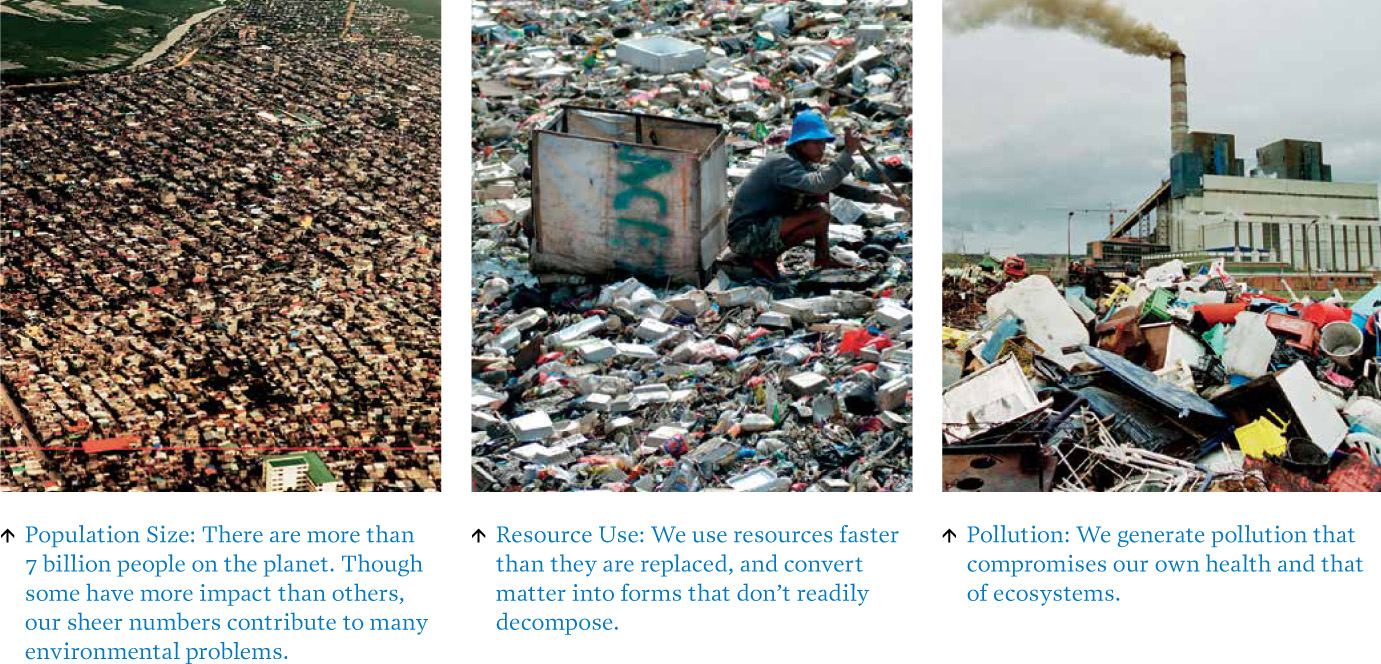1.5 Humans are an environmental force that impacts Earth’s ecosystems.
When it comes to the environment, modern societies are not as different from the Vikings as one might assume. Vikings chose livestock and farming methods that were ill-suited to Greenland’s climate and natural environment. We too use farming practices that strip away topsoil and diminish the soil’s fertility. We have overharvested our forests, and in so doing have triggered a cascade of environmental consequences: loss of vital habitat and biodiversity, soil erosion, and water pollution. We have overfished and overhunted and have allowed invasive species to devastate some of our most valuable ecosystems.
In part, these problems stem from a disconnect in our understanding of the relationship between our actions and their environmental consequences. For example, unless they live nearby, many people in Canada do not realize that vast areas of forest and wetland are flooded to produce hydroelectricity, the main source of power in many provinces. Flooding destroys thousands of hectares of habitat and diverts thousands of kilometres of streams and rivers. These hydrologic alterations, and the building of large dams, allow the creation of large reservoirs to supply ‘megaprojects’ in northern Ontario and Quebec. We are slow to make the connection between this extensive flooding and mercury contamination of fish.
8
In part, these problems stem from a disconnect in our understanding of the relationship between our actions and their environmental consequences.
We also face a suite of new problems that did not trouble the Vikings. Chief among them is population growth; as we will discuss in subsequent chapters, global population is poised to top 9 billion come 2050. The sheer volume of people will strain Earth’s resources like never before. This is relevant because every environment has a carrying capacity—the population size that an area can support indefinitely—but some of our actions are decreasing carrying capacity, even as our population swells (see Chapter 4 for more on human populations and carrying capacity). In addition, we generate more pollution than the Vikings did, and much of what we generate is more toxic.
Environmental scientists evaluate the impact any population has on its environment—due to the resources it takes and the waste it produces—by calculating its ecological footprint (see Chapter 5). Some analysts feel we have already surpassed the carrying capacity of Earth; our collective footprint already surpasses what Earth can support over a long period of time.
Another serious consequence of larger populations, increasing affluence, and more sophisticated technology is anthropogenic climate change. While the Vikings had to contend with periodic warming and cooling periods that were part of the natural climate cycle, the vast majority of scientists today conclude that modern humans are faced with rapidly warming temperatures caused largely by our own use of greenhouse gas-emitting fossil fuels.
Scientists have coined the term “ecocide”—wilful destruction of the natural environment—to describe this constellation of forces, which, as Diamond writes, have “come to overshadow nuclear war and emerging diseases as the biggest threat to global civilization.”
We have something else in common with the Vikings of Greenland: our attitudes frequently prevent us from responding effectively to environmental changes. According to Diamond, the Vikings were stymied by their own sense of superiority. They considered themselves masters of their surroundings and so they did not notice signs that they were causing irreparable harm to their environment, nor did they bother to learn the ways of their Inuit neighbours who had managed to survive in the same region for centuries before their arrival.

9
Our own attitudes can also help or hurt our ability to respond to changes. These attitudes tend to fall into one of a few groups, and range from pessimistic to more optimistic to pragmatic. [infographic 1.4]

The United Nations’ Millennium Ecosystem Assessment looks at how environmental problems affect humans and makes recommendations about addressing those problems. According to its 2005 assessment, a consensus report of more than 1500 scientists, human actions are so straining the environment that the ability of the planet’s ecosystems to sustain future generations is gravely imperiled. But there is hope: if we act now, the report’s authors write, we can still reverse much of the damage. Some of the best lessons about how we can do this come from the natural environment itself.